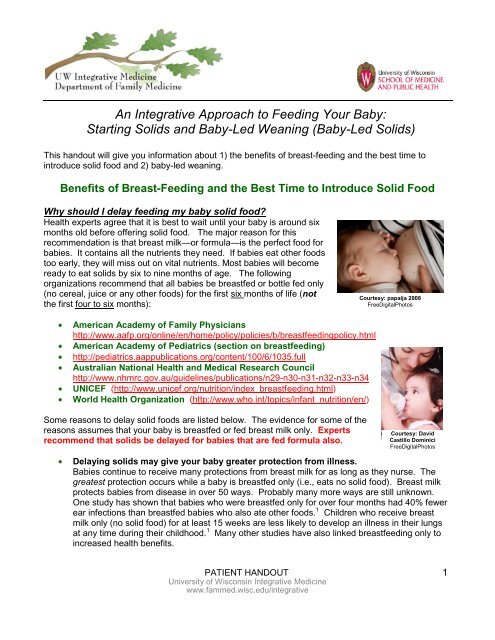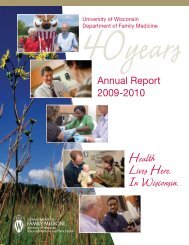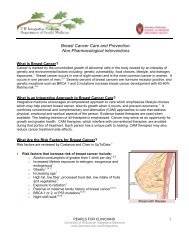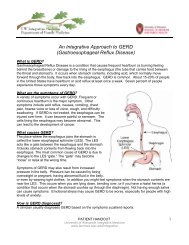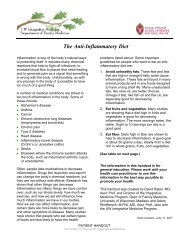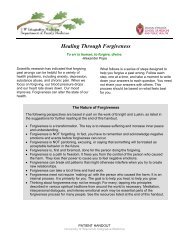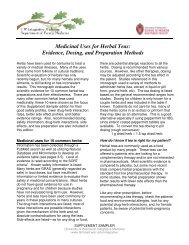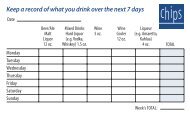An Integrative Approach to Feeding Your Baby - UW Family ...
An Integrative Approach to Feeding Your Baby - UW Family ...
An Integrative Approach to Feeding Your Baby - UW Family ...
You also want an ePaper? Increase the reach of your titles
YUMPU automatically turns print PDFs into web optimized ePapers that Google loves.
<strong>An</strong> <strong>Integrative</strong> <strong>Approach</strong> <strong>to</strong> <strong>Feeding</strong> <strong>Your</strong> <strong>Baby</strong>:Starting Solids and <strong>Baby</strong>-Led Weaning (<strong>Baby</strong>-Led Solids)This handout will give you information about 1) the benefits of breast-feeding and the best time <strong>to</strong>introduce solid food and 2) baby-led weaning.Benefits of Breast-<strong>Feeding</strong> and the Best Time <strong>to</strong> Introduce Solid FoodWhy should I delay feeding my baby solid food?Health experts agree that it is best <strong>to</strong> wait until your baby is around sixmonths old before offering solid food. The major reason for thisrecommendation is that breast milk—or formula—is the perfect food forbabies. It contains all the nutrients they need. If babies eat other foods<strong>to</strong>o early, they will miss out on vital nutrients. Most babies will becomeready <strong>to</strong> eat solids by six <strong>to</strong> nine months of age. The followingorganizations recommend that all babies be breastfed or bottle fed only(no cereal, juice or any other foods) for the first six months of life (notthe first four <strong>to</strong> six months):Courtesy: papaija 2008FreeDigitalPho<strong>to</strong>sAmerican Academy of <strong>Family</strong> Physicianshttp://www.aafp.org/online/en/home/policy/policies/b/breastfeedingpolicy.htmlAmerican Academy of Pediatrics (section on breastfeeding)http://pediatrics.aappublications.org/content/100/6/1035.fullAustralian National Health and Medical Research Councilhttp://www.nhmrc.gov.au/guidelines/publications/n29-n30-n31-n32-n33-n34UNICEF (http://www.unicef.org/nutrition/index_breastfeeding.html)World Health Organization (http://www.who.int/<strong>to</strong>pics/infant_nutrition/en/)Some reasons <strong>to</strong> delay solid foods are listed below. The evidence for some of thereasons assumes that your baby is breastfed or fed breast milk only. Expertsrecommend that solids be delayed for babies that are fed formula also.Courtesy: DavidCastillo DominiciFreeDigitalPho<strong>to</strong>sDelaying solids may give your baby greater protection from illness.Babies continue <strong>to</strong> receive many protections from breast milk for as long as they nurse. Thegreatest protection occurs while a baby is breastfed only (i.e., eats no solid food). Breast milkprotects babies from disease in over 50 ways. Probably many more ways are still unknown.One study has shown that babies who were breastfed only for over four months had 40% fewerear infections than breastfed babies who also ate other foods. 1 Children who receive breastmilk only (no solid food) for at least 15 weeks are less likely <strong>to</strong> develop an illness in their lungsat any time during their childhood. 1 Many other studies have also linked breastfeeding only <strong>to</strong>increased health benefits.PATIENT HANDOUT 1University of Wisconsin <strong>Integrative</strong> Medicinewww.fammed.wisc.edu/integrative
<strong>An</strong> <strong>Integrative</strong> <strong>Approach</strong> <strong>to</strong> <strong>Feeding</strong> <strong>Your</strong> <strong>Baby</strong>Delaying solids will give your baby's digestive system time <strong>to</strong> mature.A baby’s digestive system develops as the baby grows. Babies’ s<strong>to</strong>machs and intestinesare not ready <strong>to</strong> digest food more complicated than breast milk or formula until they arealmost six months old. If solids are started before a baby's system is ready <strong>to</strong> handlethem, they are poorly digested. This may cause upset s<strong>to</strong>mach, gas, and constipation.S<strong>to</strong>mach acid and enzymes needed <strong>to</strong> digest food do not reach adequate levels until atleast six months of age.Delaying solids may decrease the risk of food allergies for your baby.Experts do not agree on this. From birth until somewhere between four and six months ofage, babies have an "open gut." This means that the spaces between the cells of thesmall intestines allow proteins, fats and carbohydrates <strong>to</strong> pass directly in<strong>to</strong> thebloodstream. This is great for your breastfed baby. It allows helpful antibodies in breastmilk <strong>to</strong> pass more directly in<strong>to</strong> the baby's bloodstream. <strong>An</strong>tibodies (sIgA) from breast milkcoat the baby's digestive tract. This can reduce the likelihood of illness and food allergiesbefore the gut closes. Babies start making these antibodies on their own around sixmonths of age. By this time, the spaces in the gut will usually close as well.The “open gut” also means that large proteins from foods other than breast milk andformula, as well as organisms that cause diseases, can pass directly in<strong>to</strong> your baby’sbloodstream <strong>to</strong>o. In this way your baby could be introduced <strong>to</strong> allergies and diseases at ayoung age. Some studies show that feeding small amounts of food at a very early agereduces the risk for a child <strong>to</strong> develop a food allergy. 2,3 At this time, we do not haveenough evidence <strong>to</strong> recommend one approach over the other--i.e., either early or delayedfeeding of solids--<strong>to</strong> prevent food allergies.Delaying solids helps <strong>to</strong> protect babies from iron-deficiency anemia.<strong>An</strong>emia is a condition in which the body has <strong>to</strong>o few red blood cells. (Red blood cellscarry oxygen <strong>to</strong> all parts of the body.) Giving babies iron supplements or foods fortifiedwith iron, especially during their first six months, reduces their ability <strong>to</strong> absorb the ironthey need. Healthy, full-term infants who are breastfed only for six <strong>to</strong> nine months areable <strong>to</strong> maintain normal levels of iron in their blood. In one study, researchers found thatbabies who were breastfed only for seven months (and were not give iron supplements oriron-fortified cereals) had higher iron levels in their blood at one year than breastfedbabies who received solid foods earlier than seven months. 4 The researchers found nocases of anemia within the first year in babies who were breastfed only for seven months.They concluded that breastfeeding, without adding other foods, for seven months reducesthe risk of anemia.Delaying solids helps <strong>to</strong> protect babies from future obesity and diabetes.Introducing solids early appears <strong>to</strong> increase body fat and weight in childhood. 1,5,6Increased weight can lead <strong>to</strong> diabetes.Delaying solids makes eating easier for your baby.Babies who start solids later can grab food and get it <strong>to</strong> their mouths, sit up well, and havemore coordinated <strong>to</strong>ngue movements.PATIENT HANDOUT 2University of Wisconsin <strong>Integrative</strong> Medicinewww.fammed.wisc.edu/integrative
<strong>An</strong> <strong>Integrative</strong> <strong>Approach</strong> <strong>to</strong> <strong>Feeding</strong> <strong>Your</strong> <strong>Baby</strong>When should my baby start eating solid foods?There comes a time when breast milk and formula no longer supply all your baby's nutritionalneeds. A full term baby will start requiring iron from other sources by six <strong>to</strong> nine months of age.The calories supplied by breast milk or formula may become inadequate by eight <strong>to</strong> nine monthsof age. A baby may grow well on breastfeeding alone. This is not a reason <strong>to</strong> delay feedingsolids when the baby is obviously ready for them. Usually your baby will want <strong>to</strong> eat solids just asyou do. <strong>Baby</strong> is growing up!The best time <strong>to</strong> start solids is when your baby is showing interest in starting. Some babies willbecome very interested in the food on their parents' plates as early as four months of age. Byfive or six months of age, most babies will be reaching and trying <strong>to</strong> grab food that parents haveon their plates. A reasonable time <strong>to</strong> start letting your baby eat is when the baby is starting <strong>to</strong>reach for food, grabs it, and tries <strong>to</strong> put it in<strong>to</strong> her/his mouth. Go by the baby's cues.A breastfed baby digests solid foods better and earlier than a baby who is fed formula. This isbecause breast milk contains enzymes that help digest fats, proteins, and starch. Also, breastfedbabies have already tasted a wide variety of food, since the flavors of many foods the mothereats passes in<strong>to</strong> her milk. Breastfed babies thus accept solids more readily than babies whohave been on formula. Breastfeeding is amazing!How should I introduce solids <strong>to</strong> my baby?Following are some suggestions for introducing solids <strong>to</strong> your baby. (Also see page 8 for asummary that you can post in your kitchen.)It does not matter what foods you start with or the order you introduce foods. Avoid highlyspiced or high fat foods at first. If your baby reaches for food on your plate, such as apota<strong>to</strong>, make sure it is not <strong>to</strong>o hot, and then let your baby have the pota<strong>to</strong>. There is noneed <strong>to</strong> introduce foods in any specific order. There is also no need for your baby <strong>to</strong> ea<strong>to</strong>nly one food for a certain period of time.NOTE: There is nothing magic or necessary about infant cereal. It has littlenutritional value. <strong>Your</strong> baby is better off eating fruits, vegetables, and meats.Offer the foods that interest your baby.Allow your baby <strong>to</strong> enjoy food. Do not worry exactly how much your baby actually takesat first. Much of it may end up in baby’s hair and on the floor anyhow. Why limit theamount <strong>to</strong> one teaspoon if your baby wants more?There is no need <strong>to</strong> puree foods if your baby is six months of age or older. You also donot need <strong>to</strong> waste your money on commercial baby foods. Simple mashing with a fork isall that is necessary at first Mash the foods the rest of your family will eat prior <strong>to</strong>seasoning and offer those <strong>to</strong> your baby.Be relaxed. Feed the baby at your mealtimes. As your baby becomes better at eatingsolid foods, offer a greater variety of foods at any one time. Do not make mealtimes abattle. If your baby refuses, or shows signs of disinterest, do not push. Simply offer.PATIENT HANDOUT 3University of Wisconsin <strong>Integrative</strong> Medicinewww.fammed.wisc.edu/integrative
<strong>An</strong> <strong>Integrative</strong> <strong>Approach</strong> <strong>to</strong> <strong>Feeding</strong> <strong>Your</strong> <strong>Baby</strong>The easiest way <strong>to</strong> get extra iron for your baby five or six months of age is by offeringmeat or apricots. You can simmer dried apricots in water and then use a blender <strong>to</strong> makethem easier <strong>to</strong> eat. Infant cereal has iron, but it is poorly absorbed and may cause thebaby <strong>to</strong> be constipated.If you wish your baby <strong>to</strong> be vegetarian, the following books offer some good guidelines:‣ Raising Vegetarian Children: A Guide <strong>to</strong> Good Health and <strong>Family</strong> Harmony byJoanne Stepaniak and Vesan<strong>to</strong> Melina. Published by McGraw-Hill in 2002.‣ New Vegetarian <strong>Baby</strong> by Sharon Yntema and Christine Beard. Published by McBooksPress in 1999.There is no need <strong>to</strong> introduce vegetables before fruit. Breast milk isfar sweeter than fruit, so there is no reason <strong>to</strong> believe that your babywill eat vegetables better if you hold off on fruit.Respect your baby's likes and dislikes. There is no essential food. Ifyour baby does not like a certain food, do not push it. If you think it isan important food, wait a few weeks and offer it again.At about eight months of age, babies start asserting their individuality.<strong>Your</strong> baby may not want you <strong>to</strong> put a spoon in<strong>to</strong> her/his mouth. He/shemay want <strong>to</strong> take the spoon out of your hand and put it in<strong>to</strong> the mouthher/himself, often upside down, so that the foodfalls on the lap. Respect your baby's attempts at self-sufficiency andencourage learning.<strong>Baby</strong>-Led WeaningInterest has increased recently in a movement called “baby-led weaning.” (“Weaning,” in thiscase, does not mean s<strong>to</strong>pping breastfeeding or formula feeding, it means starting solids.) <strong>Baby</strong>ledweaning is a way <strong>to</strong> introduce solids <strong>to</strong> your baby while skipping the puree/cereal stage offoods al<strong>to</strong>gether. This method allows babies <strong>to</strong> control what they eat by feeding themselves.There is no spoon-feeding in baby-led weaning! <strong>Your</strong> baby moves gradually from getting mostnutrition from breast milk or formula <strong>to</strong> getting most nutrition from solid foods, like older childrenand adults do. It is up <strong>to</strong> the baby <strong>to</strong> decide how much <strong>to</strong> eat and what <strong>to</strong> eat.At first, your baby may not eat anything at all. He/she may just pick food up. The first foods ababy eats will add <strong>to</strong> the nutrients already coming from breast milk or formula. In the beginning,curiosity motivates babies <strong>to</strong> try solids, not hunger. Babies do not think <strong>to</strong> themselves, “Boy, Icould use some vegetables, I think I should eat some asparagus.” No way. They say, “Mom’sdoing it, my sister’s doing it, and I want <strong>to</strong> be like them! It looks like fun.” Eating for a baby isabout a desire <strong>to</strong> explore the world around her/him and mimic the activities of others.PATIENT HANDOUT 4University of Wisconsin <strong>Integrative</strong> Medicinewww.fammed.wisc.edu/integrative
<strong>An</strong> <strong>Integrative</strong> <strong>Approach</strong> <strong>to</strong> <strong>Feeding</strong> <strong>Your</strong> <strong>Baby</strong>Foods <strong>to</strong> start with:Start with whatever you are eating, minus the seasoning. Fruit, vegetables, cheese, meat,well cooked eggs, bread/<strong>to</strong>ast, rice, pasta are all good options. If vegetables are veryhard, they may need <strong>to</strong> be lightly cooked so that they are soft enough <strong>to</strong> chew. Chickenleg bones can be gnawed on, with a little meat left on. Just be sure <strong>to</strong> remove any smallbones and gristle before offering it <strong>to</strong> baby.To start out, choose foods that are easy <strong>to</strong> cut in<strong>to</strong> sticks or large strips. At the beginning,your baby knows how <strong>to</strong> grasp, but not release, so small finger foods will be <strong>to</strong>o <strong>to</strong>ugh <strong>to</strong>handle. Babies do best with food that has a built-in handle, like broccoli. The ideal sizewill be a piece about the size of her fist.NEVER leave your baby alone with food.Foods <strong>to</strong> avoid:NutsHoney until age oneFoods with added salt and sugarFast foodUnder-cooked eggsFoods <strong>to</strong> modify:Grapes or small <strong>to</strong>ma<strong>to</strong>es should be cut up.Cherries or olives should be cut up with pits removed.Common questions people ask:Won’t my baby choke? Lots of parents worry about choking. Doc<strong>to</strong>rs do <strong>to</strong>o. There isgood reason <strong>to</strong> believe that babies are at less risk of choking with baby-led weaning thanwith conventional feeding. That is because babies are in control of what goes in<strong>to</strong> theirmouths and at what pace. It is also important <strong>to</strong> know the difference between gaggingand choking. Gagging occurs when a morsel of food is <strong>to</strong>o large, and your baby pushes i<strong>to</strong>ut of his mouth, away from his airway, with his <strong>to</strong>ngue. Usually with babies, there is a lo<strong>to</strong>f coughing and spluttering. The baby spits out the food, possibly with some vomit, andcontinues as before. It does not bother the baby much. As adults, if we want <strong>to</strong> gag, wehave <strong>to</strong> put our finger in the back of our throats. A baby’s gag reflex is more <strong>to</strong> the middleof his <strong>to</strong>ngue, and it moves back as the baby ages. A baby’s gag reflex is also muchmore sensitive than an adult’s. When this reflex is activated, it occurs when the food iseven farther away from the airway. When a baby has triggered this reflex a few times,either by putting <strong>to</strong>o much food in<strong>to</strong> the mouth or pushing it <strong>to</strong>o far back, he/she learns not<strong>to</strong> do those things. By allowing your baby <strong>to</strong> put food in<strong>to</strong> her/his own mouth, you areletting your baby learn how <strong>to</strong> manage food safely.Why are there foods marketed as “stage 1 foods, age 4-6 months” when I’m notsupposed <strong>to</strong> be giving my baby any foods at this age? GREAT question! In somecountries there is a voluntary code of conduct <strong>to</strong> not promote any food or drink <strong>to</strong> an infantyounger than six months. Other countries have made this a law. The U.S. has doneneither, so manufacturers can label food as “suitable from four months” even though theofficial view is <strong>to</strong> wait until six months <strong>to</strong> start solids.PATIENT HANDOUT 5University of Wisconsin <strong>Integrative</strong> Medicinewww.fammed.wisc.edu/integrative
<strong>An</strong> <strong>Integrative</strong> <strong>Approach</strong> <strong>to</strong> <strong>Feeding</strong> <strong>Your</strong> <strong>Baby</strong>I have a nut allergy. Should I wait until my baby is a year old, or maybe evenlonger, before I offer anything with nuts? That’s a complicated question, and one thatinterests many researchers. There is a theory called the hygiene hypothesis that mayexplain why there has been such a dramatic rise in food allergies in the past 20 years.Simply put, the hygiene hypothesis says that when an immune system does not haveenough germs (parasites, bacteria or viruses) <strong>to</strong> fight off from the outside world, it getsbored. It then turns against itself and causes problems such as allergies and au<strong>to</strong>immunedisease. This, some researchers say, is one reason why children raised on farms haveless asthma and food allergies than city kids. Some research suggests that if youintroduce an allergen early (at six <strong>to</strong> nine months of age), a child may have a decreasedrisk of forming an allergy <strong>to</strong> that food. 7 Other studies suggest that it is best <strong>to</strong> wait until achild is beyond a year, when the immune system is more mature, <strong>to</strong> introduce a food thatmay cause an allergic reaction. 8 As you can see, there is a lot we still do not know aboutfood allergies and how <strong>to</strong> prevent them. This is a <strong>to</strong>pic <strong>to</strong> discuss with your doc<strong>to</strong>r beforemaking any final decisions.My baby doesn’t have any teeth. Should we wait before introducingsolids? If you have ever been bitten by your <strong>to</strong>othless baby, you knowthat those jaws are pretty powerful, even without teeth! Babies don’tneed teeth <strong>to</strong> bite and chew.Won’t my baby just eat the sweet stuff all the time? Now is theperfect time <strong>to</strong> set the stage for good food choices, by offering your babya variety of delicious, healthy options. Avoid offering fast foods or foodswith artificial sweeteners or salt. In a study done in the 1930s on orphanbabies who were offered a variety of foods and non-food objects(including paper!), none of the babies developed any nutritional deficiencies orinappropriate weight loss. 9 Babies give their bodies what they need. As your baby’sdevelopment continues, you can also offer dips, like yogurt or hummus, so even moreflavors can be tried.BookWebsiteYouTubeYouTubeFOR MORE INFORMATION ON BABY-LED WEANING<strong>Baby</strong>-Led Weaning: The Essential Guide <strong>to</strong> Introducing Solid Foods and Helping<strong>Your</strong> <strong>Baby</strong> <strong>to</strong> Grow Up a Happy and Confident Eater.by Gill Rapley & Tracey Murkett, published in 2010 by The Experiment.<strong>Baby</strong>-Led Weaning: The fuss-free way <strong>to</strong> introduce solid foods.www.rapleyweaning.com/<strong>Baby</strong> led weaning feature on BBC London.http://www.bing.com/videos/search?q=baby+led+weaning+BBC+London&view=detail&mid=07121B41ADA7D0F9880307121B41ADA7D0F98803&first=0&FORM=NVPFVR<strong>Baby</strong> knows best! Study shows baby-led weaning promotes healthy foodpreferences.http://www.bing.com/videos/search?q=you+tube+baby+knows+best&mid=375C3EAD1FD2D734E53E375C3EAD1FD2D734E53E&view=detail&FORM=VIRE8See page 8 for a summary of successful baby-led weaning.PATIENT HANDOUT 6University of Wisconsin <strong>Integrative</strong> Medicinewww.fammed.wisc.edu/integrative
<strong>An</strong> <strong>Integrative</strong> <strong>Approach</strong> <strong>to</strong> <strong>Feeding</strong> <strong>Your</strong> <strong>Baby</strong>REFERENCES1. Wilson AC, Forsyth JS, Greene SA et al. Relation of infant diet <strong>to</strong> childhood health: seven yearfollow up of cohort of children in Dundee infant feeding study. BMJ. 1998;316:21-25.2. Norris JM, Barriga K, Hoffenberg EJ et al. Risk of celiac disease au<strong>to</strong>immunity and timing of glutenintroduction in the diet of infants at increased risk of disease. JAMA. 2005;293:2343-2351.3. Ivarsson A, Myleus A, Norstrom F et al. Prevalence of childhood celiac disease and changes ininfant feeding. Pediatrics. 2013;131(3):e687-e694(doi:10.1542/peds.2012-1015).4. Pisacane A, De Vizia B, Valiante A et al. Iron status in breast-fed infants. J Pediatr.1995;127(3):429-431.5. von Kries R, Koletzko B, Sauerwald T. Breast feeding and obesity: cross sectional study. BMJ.1999;319 (7203):147-150.6. Kalies H, Heinrich J., Borte N et al. The effect of breastfeeding on weight gain in infants: results ofa birth cohort study. Eur J Medical Res. 2005;10(1):36-42.7. Greer F, Sicherer SH, Burks AW. Effects of early nutritional interventions on the development ofa<strong>to</strong>pic disease in infants and children: the role of maternal dietary restriction, breastfeeding, timingof introduction of complementary foods, and hydrolyzed formulas. Pediatrics. 2008;121(1):183-191.8. Zeiger RS, Heller S, Mellon MH et al. Effect of combined maternal and infant food-allergenavoidance on development of a<strong>to</strong>py in early infancy: a randomized study. J Allergy Clin Immunol.1989;84(1):72-89.9. Davis C. Results of the self-selection of diets by young children. Read at the Seventieth <strong>An</strong>nualMeeting, Canadian Medical Association, Section of Pædiatrics, Montreal, June 21, 1939.10. Rapley G, Murkett T. <strong>Baby</strong>-Led Weaning: The Essential Guide <strong>to</strong> Introducing Solid Foods andHelping <strong>Your</strong> <strong>Baby</strong> <strong>to</strong> Grow Up a Happy and Confident Eater. New York: The Experiment, 2010.The information in this handout is for general education. It is not meant <strong>to</strong> be used by apatient alone. Please work with your health care practitioner <strong>to</strong> use this information inthe best way possible <strong>to</strong> promote the health and happiness of your baby and yourself.This handout was created by Samantha Sharp, MD, Fellow, <strong>Integrative</strong> Medicine Program,Department of <strong>Family</strong> Medicine, University of Wisconsin-Madison School of Medicine and PublicHealth.Date Created: April 2013Notes:PATIENT HANDOUT 7University of Wisconsin <strong>Integrative</strong> Medicinewww.fammed.wisc.edu/integrative
<strong>An</strong> <strong>Integrative</strong> <strong>Approach</strong> <strong>to</strong> <strong>Feeding</strong> <strong>Your</strong> <strong>Baby</strong>SummarySecrets from Successful <strong>Baby</strong>-Led Weaning 10(You may want <strong>to</strong> post this in your kitchen as a reminder.)Sit your baby upright either in a high chair or on your lap. Make sure your baby issteady and can use her/his hands and arms freely.Offer your baby food, rather than feeding. Put it in front of your baby. Let your babydecide whether or not <strong>to</strong> try it.Think of meal times as play times in the beginning. Babies are learning andexperimenting-not necessarily eating. That is okay.Start with foods that are easy <strong>to</strong> pick up. Thick sticks or long strips are best at first.Gradually introduce new shapes and textures, so that your baby can work out how <strong>to</strong>handle them.Do not expect your baby <strong>to</strong> eat much food at first. <strong>Your</strong> baby is still getting mostnutrition from the breast or bottle until age one. Many babies eat very little the first fewmonths.Expect some mess. Put a plastic sheet under your baby, so that dropped food can behanded back. Consider a long-sleeve bib or a long-sleeve but<strong>to</strong>n down shirt that can beworn backward <strong>to</strong> keep your baby clean.Continue <strong>to</strong> breastfeed or formula feed as before, so that your baby’s food adds <strong>to</strong> themilk, rather than replaces it. <strong>Your</strong> baby will reduce feedings gradually when ready.Offer your baby water <strong>to</strong> drink with meals.Try <strong>to</strong> eat with your baby and include her/him in meal times whenever possible.<strong>Your</strong> baby will then have plenty of opportunities <strong>to</strong> copy you and practice new skills.Choose times when your baby is not tired or hungry. <strong>Your</strong> baby can then concentrateon learning this new skill.Keep it enjoyable, for everyone! We all know that a relaxed atmosphere is important forlearning. By making sure that mealtimes are relaxed and enjoyable, your baby will beexcited <strong>to</strong> try new foods and look forward <strong>to</strong> meal time.NEVER leave your baby alone with food.10 From Rapley G, Murkett T. <strong>Baby</strong>-Led Weaning: The Essential Guide <strong>to</strong> Introducing Solid Foods andHelping <strong>Your</strong> <strong>Baby</strong> <strong>to</strong> Grow Up a Happy and Confident Eater. New York: The Experiment, 2010.PATIENT HANDOUT 8University of Wisconsin <strong>Integrative</strong> Medicinewww.fammed.wisc.edu/integrative


